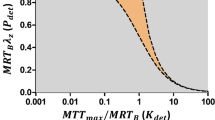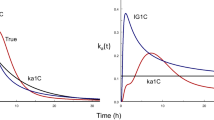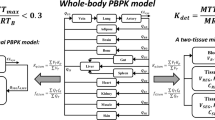Abstract
Equations for the mean residence times in the body (MRT) and in the central compartment (MRTc) are derived for bolus central dosing of a drug and its metabolite which undergo linear tissue distribution and linear reversible metabolism but are eliminated either linearly or nonlinearly (Michaelis–Menten kinetics) from the central compartments. In addition, a new approach to calculate the steady-state volumes of distribution for nonlinear systems (reversible or nonreversible) is proposed based on disposition decomposition analysis. The application of these equations to a dual reversible two-compartment model is illustrated by computer simulations.
Similar content being viewed by others
REFERENCES
L. Aarons. Mean residence time for drugs subject to reversible metabolism. J. Pharm. Pharmacol. 39:565–567 (1987).
H. Cheng and W. J. Jusko. Mean residence times of multicompartment drugs undergoing reversible metabolism. Pharm. Res. 7:103–107 (1990).
P. Veng-Pedersen and W. R. Gillespie. Single pass mean residence time in peripheral tissues: A distribution parameter intrinsic to the tissue affinity of a drug. J. Pharm. Sci. 75:1119–1126 (1986).
W. R. Gillespie and P. Veng-Pedersen. Theorems and implications of a model-independent elimination/distribution function decomposition of linear and some nonlinear drug dispositions. II. Clearance concepts applied to the evaluation of distribution kinetics. J. Pharmacokinet. Biopharm. 13:441–451 (1985).
D. J. Cutler. Definition of mean residence times in pharmacokinetics. Biopharm. Drug Dispos. 8:87–97 (1987).
C. M. Metzler and D. L. Weiner. PCNONLIN—User's Guide, Statistical Consultants, Inc., Lexington, Ky., 1984.
M. L. Rocci and W. J. Jusko. LAGRAN program for area and moments in pharmacokinetic analysis. Comp. Prog. Biomed. 16:203–216 (1983).
W. F. Ebling and W. J. Jusko. The determination of essential clearance, volume, and residence time parameters of recirculating metabolic systems: The reversible metabolism of methylprednisolone and methylprednisone in rabbits. J. Pharmacokinet. Biopharm. 14:557–599 (1986).
P. Veng-Pedersen. Theorems and implications of a model independent elimination/distribution function decomposition of linear and some nonlinear drug dispositions. I. derivations and theoretical analysis. J. Pharmacokinet. Biopharm. 12:627–647 (1984).
P. Veng-Pedersen, H. Cheng, and W. J. Jusko. A note regarding dose independent pharmacokinetic parameters in nonlinear pharmacokinetics J. Pharm. Sci., in press (1991).
Author information
Authors and Affiliations
Rights and permissions
About this article
Cite this article
Cheng, H., Jusko, W.J. Mean Residence Times and Distribution Volumes for Drugs Undergoing Linear Reversible Metabolism and Tissue Distribution and Linear or Nonlinear Elimination from the Central Compartments. Pharm Res 8, 508–511 (1991). https://doi.org/10.1023/A:1015811514050
Issue Date:
DOI: https://doi.org/10.1023/A:1015811514050




